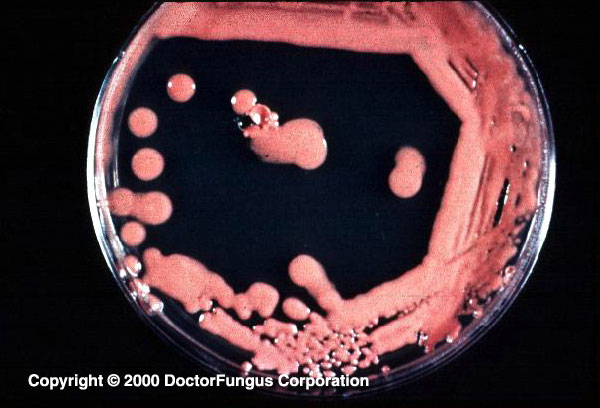(described by Harrison in 1927)
Taxonomic Classification
Kingdom: Fungi
Phylum: Basidiomycota
Class: Urediniomycetes
Order: Sporidiales
Family: Sporidiobolaceae
Genus: Rhodotorula
Description and Natural Habitats
Rhodotorula is a yeast found in air, soil, lakes, ocean water, and dairy products. It may colonize plants, humans [1968], and other mammals. While being considered as a common contaminant, Rhodotorula may infect individuals with predisposing risk factors. One of its species, Rhodotorula glutinis has known teleomorphs in the genus Rhodosporidium. These teleomorphs are Rhodosporidium diobovatum, Rhodosporidium sphaerocarpum, and Rhodosporidium toruloides [531].
Species
The genus Rhodotorula includes three active species; Rhodotorula glutinis, Rhodotorula minuta, and Rhodotorula mucilaginosa. Rhodotorula mucilaginosa is the current name for the species formerly known as Rhodotorula rubra. Since it has been shown that the type strain of Rhodotorula rubra is actually a strain of Rhodotorula glutinis and the type strain of Rhodotorula mucilaginosa is identical to the type strain for Rhodotorula rubra, Rhodotorula mucilaginosa is the current name for Rhodotorula rubra.
See the summary of synonyms and teleomorph-anamorph relations for the Rhodotorula spp.
Pathogenicity and Clinical Significance
Rhodotorula spp. are rarely isolated as causative agents of opportunistic mycoses [48, 62, 908, 1251] in vulnerable hosts, such as patients with AIDS or acute leukemia. Cases of meningitis [960, 1089, 1830], endocarditis [1627], ventriculitis, peritonitis, endophthalmitis [1800], central venous catheter-infections, fungemia, and sepsis [48, 857, 1189, 1769, 2014] have so far been reported.
Macroscopic Features
Colonies are rapid growing, smooth, glistening or dull, sometimes roughened, soft and mucoid. They are cream to pink, coral red, orange or yellow in color [531, 1295, 2202].
Rhodotorula does not ferment carbohydrates and produces urease enzyme. Noteworthy, Rhodotorula mucilaginosa, when it contaminates the tested serum sample, may cross-react with and result in false positive results of Pastorex Aspergillus antigen latex agglutination test [1153].
Microscopic Features
Blastoconidia that are unicellular, and globose to elongate in shape are observed. These blastoconidia may be encapsulated. Pseudohyphae are absent or rudimentary. Hyphae are absent [531, 1295, 2202].
Compare to
Cryptococcus neoformans
Candida spp.
Rhodotorula differs from Cryptococcus by its inability to assimilate inositol and from Candida by producing pink-to-red colonies and lacking pseudohyphae.
Laboratory Precautions
No special precautions other than general laboratory precautions are required.
Susceptibility
Limited data are available. For isolates of Rhodotorula mucilaginosa, amphotericin B yielded the lowest MICs, followed by itraconazole and voriconazole. Fluconazole did not have any meaningful in vitro activity against Rhodotorula mucilaginosa [686, 857]. In another study, the MICs of amphotericin B and posaconazole were found to be lowest, while those of triazoles and echinocandins were relatively high [2480].
For MICs of various antifungal drugs for Rhodotorula, see our N/A(L):susceptibility database.
Amphotericin B or its lipid formulations are preferred for treatment of Rhodotorula infections [857, 1387]. In cases associated with the existence of central venous catheters for extended durations, removal of the catheter is also indicated along with antifungal therapy. A case of endocarditis succesfully treated with oral flucytosine [1627] and a patient with transient fungemia that resolved without any antifungal therapy [2014] have also been reported.

